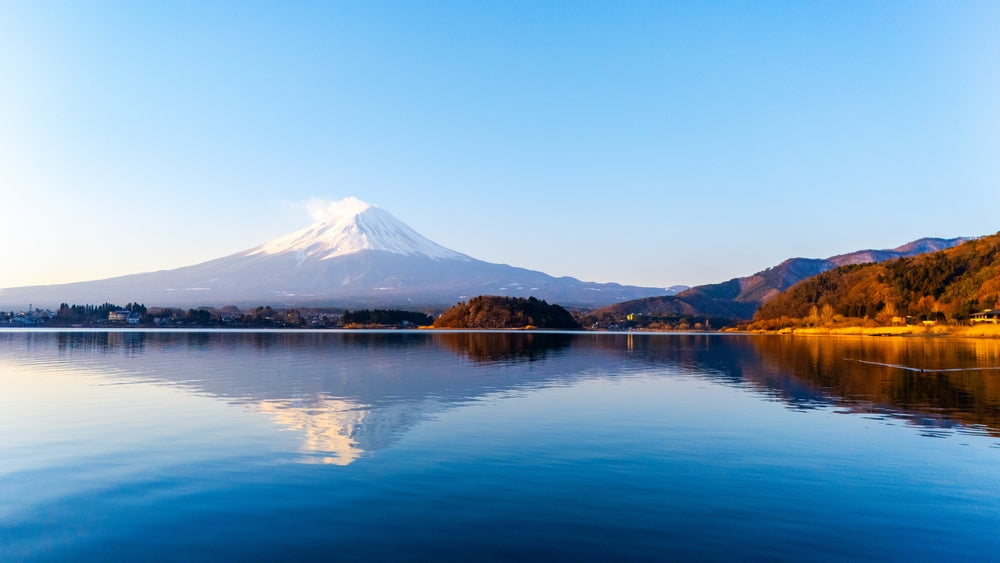
Mt. Fuji - Japan’s Sacred Peak and Timeless Icon
Towering above the Japanese landscape at 3,776 meters, Mt. Fuji is more than just Japan’s highest peak — it’s a national icon woven deeply into the country’s culture, history, and spirit. Whether admired from afar, captured in centuries of art, or climbed by thousands each summer, Mt. Fuji continues to amaze people with its beauty and presence. On clear days, I can even spot it from my apartment — a quiet yet powerful sight that never fails to lift my mood. In this post, I’d love to take you on a journey through the many faces of Fuji — from its sacred significance to its seasonal beauty — and share my own connection to this majestic mountain, along with a few Fuji-themed treasures available at our store.
1. Basic Facts & UNESCO World Heritage Status
Mt. Fuji, or Fujisan as it's called in Japanese, is the highest mountain in Japan, standing proudly at 3,776 meters (12,389 feet). Located on Honshu island, it straddles the borders of Shizuoka and Yamanashi prefectures — in fact, it's so vast that it’s visible from several provinces and even from Tokyo on a clear day.
Mt. Fuji is an active stratovolcano, though it hasn’t erupted since 1707. Its nearly symmetrical cone, often capped with snow, has become an instantly recognizable symbol of Japan around the world.
In 2013, Mt. Fuji was officially designated a UNESCO World Cultural Heritage Site. Interestingly, it was not recognized for its geology, but rather for its cultural and spiritual significance. UNESCO highlighted 25 surrounding sites, including shrines, pilgrim routes, and viewing spots, that show how the mountain has inspired generations of artists, poets, monks, and everyday people.
Whether seen from the ground, from the air, or up close during a climb, Mt. Fuji isn’t just a natural wonder — it’s deeply tied to the identity and imagination of Japan.

2. Cultural & Spiritual Significance
For centuries, Mt. Fuji has been more than just a mountain — it has been a sacred presence in the lives of the Japanese people.
-
A Sacred Mountain in Shinto
In Shinto belief, Mt. Fuji is considered the home of Konohanasakuya-hime, the blossom goddess. Shrines like Fujisan Hongū Sengen Taisha have made the mountain a sacred pilgrimage site for centuries, and even today, many climbers offer prayers before their ascent.
-
A Site of Pilgrimage and Practice
During the Edo period, Fuji became a major pilgrimage destination. Devotees followed established trails, stopping at shrines and collecting stamps along the way — a tradition still echoed by modern climbers.
-
Symbol in Both Shinto and Buddhism
While Shinto reveres the mountain as a divine presence, Buddhist monks saw it as a place for spiritual training. Yamabushi (mountain monks) practiced meditation and rituals on its slopes to seek enlightenment.
-
Endless Source of Artistic Inspiration
Mt. Fuji appears in countless works of art, poetry, and literature — most famously in Hokusai’s Thirty-Six Views of Mt. Fuji. Even centuries earlier, classical poets praised its majesty in ancient collections like the Manyōshū.
-
A Symbol of Japanese Identity
Straddling religious traditions and inspiring generations, Mt. Fuji stands as a cultural icon — one that reflects Japan’s reverence for nature, beauty, and spiritual connection.
3. Seasonal Beauty
One of the reasons Mt. Fuji continues to captivate people is how dramatically it changes with the seasons — almost like it has many personalities throughout the year.
-
Spring brings cherry blossoms to the surrounding areas, especially around places like Chureito Pagoda or Lake Kawaguchi, creating postcard-perfect scenes of pink petals and a snow-capped peak.
-
In summer, the snow melts, revealing Fuji’s dark, volcanic surface. This is also the official climbing season (July to early September), when thousands of trekkers set out to reach the summit.
-
Autumn adds vibrant red and gold foliage to the foothills, offering incredible contrast with the crisp blue sky and lingering traces of snow at the top.
- And in winter, Mt. Fuji becomes a dramatic presence — fully covered in snow and visible from great distances on clear days. It feels quiet and powerful, especially when viewed from warm spots like an onsen (hot spring).
No matter the season, Mt. Fuji has a way of making you pause and look up — its shape constant, but its mood always shifting.

